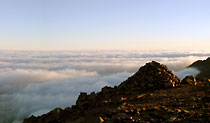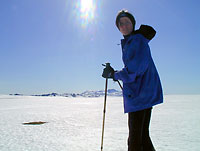Weather in Iceland

It’s not as cold as you might think! In fact, for this latitude, it’s surprisingly mild. Average temperatures in the lowlands are around 10°C/50°F in the summer and about –2°C/28°F in the winter. Temperature fluctuations are common and there can easily be a difference of 10°C/50°F from one day to the next. In winter the temperature tends to hover just above and below freezing.
Iceland is a windy place. In the summer there can be storms, although they are not so common. In the winter, you may expect two or three storms every two weeks or so, especially in the highlands and by the glaciers.
Sometimes we get the torrential rain common in many southern countries, but in the summer it is more common to have heavy downpours interspersed with overcast, dry patches. Such a weather pattern may persist for days. A similar pattern is true for the winter, although the deluge is as likely to be sleet, snow or hail (or all of the above).

The normal path of the low-pressure weather systems passes right over Iceland. The systems pass over the Atlantic Ocean from the southwest and head northeast across the island towards the Arctic Ocean. The low pressures are often responsible for the rapid changes in the weather. Like elsewhere the fronts are deeper in the winter than in the summer, causing greater fluctuations in the winter. When a large, high pressure system stalls over the island or nearby waters, make the most of it: you can expect bright, calm weather for days or even weeks.
When travelling in Iceland you should always take a look at the weather forecast and pay heed to storm warnings. The forecast can be found daily (in English) on the web site of the meteorological office.
